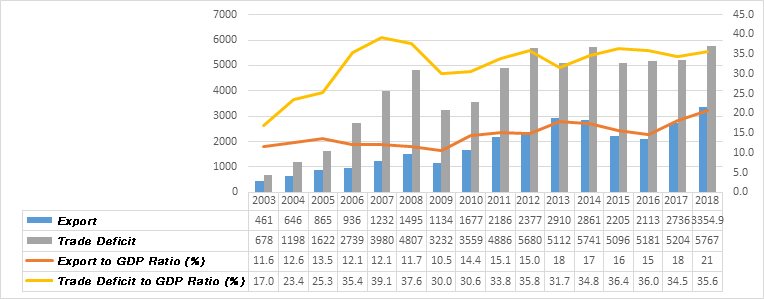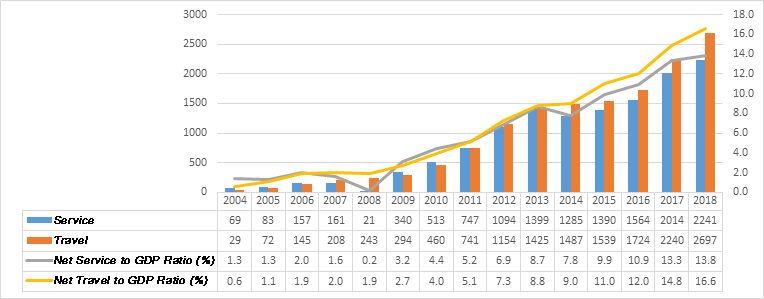Resume: A country’s balance of payments includes comprehensive data about money inflows and outflows. It also illustrates the movement of money between the economy of a specific country and the rest of the world. A country’s balance of payments consists of its current account, capital account and financial account. A current account includes the component of trading with goods and services as well as incomes and transfers. The income component shows inflows of income from abroad (specifically, labour remuneration and investment income) and incomes transferred from Georgia. Transfers include current transfers between the residents and non-residents of a country (for instance grants, financial assistance).
In 2018, the current account deficit amounted to USD 1.2 billion which constituted 7.7% of Georgia’s total GDP. As compared to 2012, the current account deficit decreased 1.54 times in 2018 and 1.66 times as compared to 2011. Therefore, the current account deficit was not halved as compared to the period under the rule of the previous government.
When speaking of record figures of export, we should analyse the export to GDP ratio. In 2018, the nominal volume of export was USD 3.3 billion (21% of the GDP) which is indeed a record-breaking figure. However, the Prime Minister did not mention that import is also at a historical maximum. In the previous year, the trade deficit did increase as compared to both 2012 and 2017; that is, import is going faster as compared to export which negates the positive of impact of export growth as referred to by the Prime Minister.
Income from services and travel (tourism) has been increasing in the past years, thereby significantly contributing to the reduction of the current account deficit. The balance of payments includes data about travel and service[1] in the form of income, expenditure and net data. Net tourism[2] and net service figures vis-à-vis the GDP are also record-breaking. In 2018, the net service constituted 13.8% of the GDP (USD 2.2 billion) whilst the net travel constituted 16.6% of the GDP (GEL 2.7 billion).
Analysis
On 23 May 2019, on air on TV Pirveli, the Prime Minister of Georgia, Mamuka Bakhtadze, stated: “We halved the current account deficit. Export is at a historical maximum and income from the service sector, including tourism, is also at a historical maximum.”
A country’s balance of payments includes comprehensive data about money inflows and outflows. It also illustrates the movement of money between the economy of a specific country and the rest of the world. A country’s balance of payments consists of its current account, capital account and financial account.
A current account includes the component of trading with goods and services as well as incomes and transfers. The income component shows inflows of income from abroad (specifically, labour remuneration and investment income) and incomes transferred from Georgia. Transfers include current transfers between the residents[3] and non-residents of a country (for instance grants, financial assistance).
In 2018, the current account deficit amounted to USD 1.2 billion which constituted 7.7% of Georgia’s total GDP. As compared to 2012, the current account deficit decreased 1.54 times in 2018 and 1.66 times as compared to 2011. The fact that the net service and the net tourism significantly increase does correspond with the Prime Minister’s statement and is a positive factor vis-à-vis the current account dynamic because of more currency inflows. The current account dynamic is given in Graph 1.
Graph 1:Current Account Deficit

Source:National Bank of Georgia
In addition, when speaking of record figures of export, we should analyse the export to GDP ratio. In 2018, the nominal volume of export was USD 3.3 billion (21% of the GDP) which is also a record-breaking figure. However, the Prime Minister did not mention that import is also at a historical maximum. However, in the previous year, the trade deficit did increase as compared to both 2012 and 2017; that is, import is growing faster as compared to export which negates the positive of impact of export growth as referred to by the Prime Minister. Apart from that, the trade deficit[4] to GDP ratio also increased by 1.1% as compared to the previous year.
Graph 2: Export Dynamic in 2003-2019 (USD Million)

Source: National Statistics Office of Georgia
Income from services and travel (tourism) has been increasing in the past years, thereby significantly contributing to the reduction of the current account deficit. When Mamuka Bakhtadze says that the service and tourism numbers are record-breaking, it is important to take a look at the relative figures. Net tourism and net service figures vis-à-vis the GDP are indeed record-breaking. In 2018, the net service constituted 13.8% of the GDP whilst the net travel constituted 16.6% of the GDP (GEL 2.7 billion).
Graph 3:Net Service and Net Tourism Components (USD Million)

Source: National Bank of Georgia
[1] The service account includes service which was provided by Georgian residents to the residents of other countries and vice versa.
[2] The net figure shows the differences between income and payables.
[3] An individual who actually resided on the territory of Georgia for more than 182 days in any 12-month period at the end of a tax year or if he has been in the public service of Georgia abroad during the course of a tax year.
[4] Export minus import.








